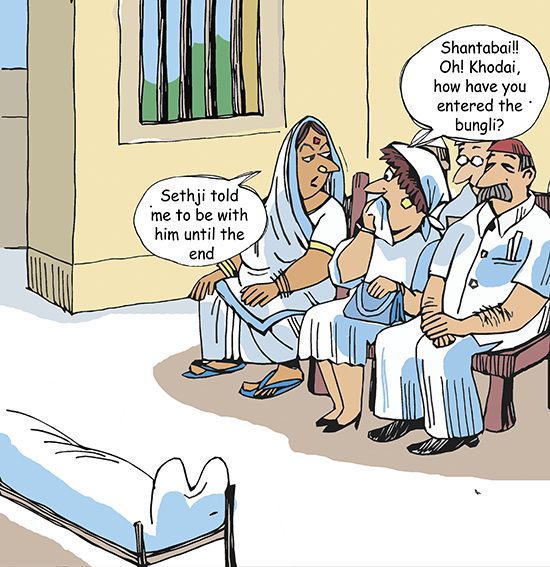A hitherto dormant controversy is simmering. This pertains to bunglis at Doongerwadi being out of bounds to non-Parsi Zoroastrians (NPZs). Are bunglis consecrated as are fire temples and dakhmas? What ecclesiastical or spiritual diktat is violated if NPZs are permitted to enter? Is there any legal basis for the trustees of Bombay Parsi Punchayet who manage Doongerwadi to deny entry to the NPZs?
Dr Sir J. J, Modi, in his authoritative work, The Religious Ceremonies and Customs of the Parsees, exhaustively lists all consecration ceremonies for dadgahs, adarians, atash behrams, towers of silence, and the nirang used in the inner liturgical ceremonies. However, there is no mention of consecrating a bungli.
None of the trust deeds relating to the Bombay Towers of Silence state that entry to a bungli is restricted to Parsi Zoroastrians only. Bunglis, like the Albless and Hodiwala, were constructed by Doongerwadi donors. However, there are no specific trust deeds governing these bunglis.

Illustration by Farzana Cooper
Across from the bunglis, there are large pavilions where NPZs are permitted to sit, watch and listen to the prayers being recited a stone’s throw away. Non-Parsi staff members move freely around the bungli. As a matter of fact, it is customary to display the body on the portico of the bungli to NPZs before the sachkar, the final ablutions.
The bungli is a latter day convenience provided by patrons for the use of the community. Conducting funerals at home became increasingly difficult in the 20th century. The bungli structures have no religious significance and are not an essential component of the Zoroastrian post-death dispensation. Barring the entry of NPZs is therefore only a practice followed by administrations which were always orthodox.
There is no authority to support the proposition that once a body is placed in the rectangular place earmarked in a corner of the bungli, the bungli is on par with a consecrated fire temple and entry is prohibited to NPZs. The orthodox argument that the nassessalars create a circuit around the body making it non transgressible applies to all persons, including Parsis.
The mainstream orthodox commentaries dwell at length on how the dakhmas are sacred, consecrated enclosures. But they are ominously silent about the bunglis being treated on par with fire temples or dakhmas. Even the ultra-orthodox groups, mostly followers of the mystic Ilm-e-Khshnoom group, are unable to cite any specific authority, however obtuse or bizarre, that a bungli during ceremonies becomes sacred.
While the Bombay Parsi Punchayet trustees display a board outside the bunglis stating NPZs are barred entry, they have no legal right to do so, say the liberals. The controversy is not only of academic interest. If the deceased was married to a non Parsi, the spouse is barred from attending the final rites; if the woman is married a non Parsi, her husband and children cannot enter the bungli for the prayers. Neither can Parsis who are not practicing Zoroastrians, such as Christian Scientists.
While most NPZs can understand the restrictions relating to fire temples, many find it deeply offensive to be prevented from offering their last respects to departed colleagues and long-standing friends. The relatives of the deceased are equally embarrassed and often squirm in discomfort when informing the NPZs they must sit separately.
There is no theological basis to bar NPZs viewing the face of the deceased during or after the prayers. Until the turn of the last century, virtually every Parsi home in Bombay had a rectangular space marked in a corner where the funeral rites were performed; and thereafter the body was carried through the streets to the dakhma, with the face uncovered. It is believed that only after the communal clashes between Parsis and Muslims (1851 to 1874), when attempts were made to defile a passing funeral procession by throwing stones, that the faces of Parsi corpses being transported were covered. Another theory is that during a cholera outbreak, the faces of deceased Parsis were covered to hide any unseemly sight. In other words, there is no theological or ecclesiastical sanction for this practice.
Over a period of time, the practice developed by which the uncovered face was covered only after the Parsi mourners had done the sezdo or the last prostration before the body, and before the NPZs lined up outside the bungli could cast their eyes on the fully enwrapped deceased.
Of course, the Khshnoomists would have you believe that a corpse is dead matter and therefore naso, a deadly contaminant both of body and spirit, against which only the racial stock of Parsi bodies are inherently protected. Hence it is taboo for non-Parsi eyes to fall on the face of the Zoroastrian deceased. Bad for the viewer, and bad for the deceased about to embark upon an arduous spiritual journey fraught with many poltergeist (mischievous spirits) phenomena.
There are liberals who favor dakhmenashini and want the Zoroastrian obsequial ceremonies performed. Nevertheless they find it demeaning to be a mute spectator to this unjustified apartheid without any doctrinal basis. In many places outside Maharashtra and Gujarat, NPZs attend the funeral rites and view the face of the deceased.
The orthodox are well aware of the unsustainability of the position that bars non Parsis and prefer to maintain silence. At the time of death, few want to create a scene, and thereafter none agitate. However, a legal challenge to this practice by some activists appears to be possible.
The austere bungli, an oasis of dignified mourning, may be about to become more welcoming to all wanting to pay their last respects, irrespective of their racial stock.
Berjis Desai, lawyer and author of Oh! Those Parsis, and recently Towers of Silence, is a chronicler of the community.